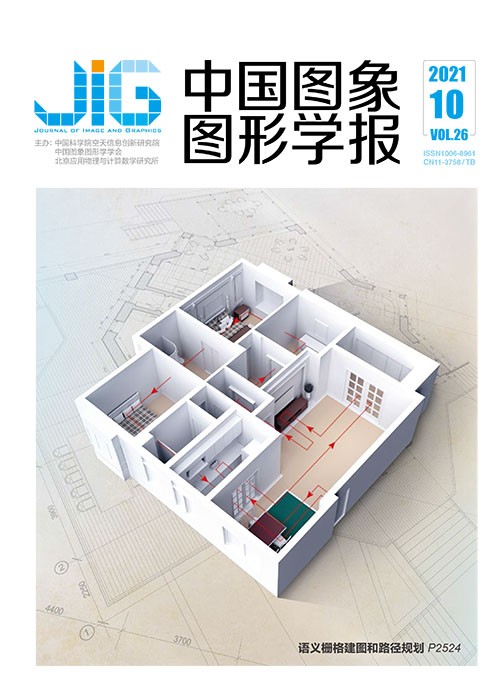
边缘与区域不一致性引导下的图像拼接篡改检测网络
摘 要
目的 针对已有图像拼接篡改检测方法中存在的真伪判断分类精度不高、拼接篡改区域定位不准确问题,本文设计了一种篡改边缘两侧和篡改区域内外不一致性引导下的重点关注篡改区域与篡改边缘的图像拼接篡改检测卷积神经网络。方法 图像内容在篡改过程中,拼接物体的边缘都会留下篡改痕迹,这是图像拼接篡改检测的重要线索。因此,本文设计了一条篡改边缘提取分支,通过学习拼接物体边缘两侧的不一致性,重点提取拼接篡改区域的边缘轮廓。考虑到篡改边缘像素点过少会导致网络难以收敛,提出一个边缘加粗策略,形成一个边缘加粗的"甜甜圈",使得篡改边缘提取结果更具完整性。在不同图像采集过程中,所用相机设备和光线条件等因素不同,导致每幅图像包含的信息也不尽相同。对此,设计了一条篡改区域定位分支,重点学习来自不同图像拼接区域与周围区域之间不一致性的差异化特征,并将注意力机制引入图像拼接篡改检测的篡改区域定位分支,进一步提高对拼接篡改区域的学习关注程度。面向真伪判断设计了一条图像是否经过拼接篡改的二分类网络分支,不但可以快速有效地给出输入图像是否为篡改图像的判断结果,而且可以与上述两条分支的输出结果一起提供给用户,由用户结合视觉语义信息进行综合判断。结果 本文算法与已有的4个代表性方法在4个专业数据集上进行算法实验和性能比较。在真伪判断分类的精确度方面,在Dresden、COCO(common objects in context)、RAISE(a raw images dataset for digital image forensics)和IFS-TC(information forensics and security technical committee)数据集上分别提高了8.3%、4.6%、1.0%和1.0%;在篡改区域定位的准确度方面,F1评分与重叠度IOU(intersection over union)指标较已有方法分别提升了9.4%和8.6%。结论 本文算法将真伪判别分类、篡改区域定位和篡改边缘提取融合在一起,互相促进,较大提升了各分支任务的性能表现,在图像拼接篡改检测方面取得了优于已有方法的效果,为数字图像取证技术领域的研究工作拓展了思路。
关键词
Edge and region inconsistency-guided image splicing tamper detection network
Jiang Xiaoyu, Liu Chunxiao(School of Computer Science and Information Engineering, Zhejiang Gongshang University, Hangzhou 310018, China) Abstract
Objective With the rapid development of internet technology, digital image processing techniques have become more and more developed in recent years. Nowadays, ordinary users can easily use various software to edit digital images. Although these falsified images can bring us some special visual or entertainment effects, they can also be maliciously tampered. These maliciously tampered images will have a huge impact on litigation evidence collection, criminal investigation, national political and military affairs, etc. Therefore, image forensics research has very important significance. Although the tampered images can be edited in various ways, this study focuses on the detection of image splicing tamper operation. The splicing process of digital images is to copy a small region of a real image and insert it into some region of another real image, so as to tamper the original image content. In the process of inserting the spliced object, some post-processing operations, such as blurring, smoothing, retouching, and blending, may also be used to hide the tampering traces, making the tampered image look more realistic and natural. To solve the problems of state-of-the-art image splicing tamper detection methods, such as low classification accuracy and coarse localizations of the spliced tamper regions, a convolutional neural network for image splicing tamper detection is designed under the guidance of the inconsistency around the tamper edges and the tamper regions to pay more attention on tamper regions and tamper edges. Method First, in the image tampering process, the tamper edges of the spliced objects leave tampering traces, which are important cues for image splicing tamper detection. Therefore, a tamper edge extraction network branch is designed in this study. By learning the inconsistency on both sides of the tamper edges of spliced objects, the tamper edges of spliced tamper regions will be extracted. Considering that it is difficult to make the network converge faster and better due to relatively few tamper edge pixels of the spliced objects, this study expands 6 pixels inward and outward along the tamper edges of the spliced objects, which forms a "doughnut" with a bold tamper edge. It drives the tamper edge extraction network branch to focus on the edge contour of the tampered object by learning the inconsistencies on both sides of the tamper edges. Second, the information contained in each image is different due to factors (e.g., camera equipment, lighting conditions, noising environment) during the image capturing process, which can be helpful in discriminating the tamper regions from their surroundings (i.e., the spliced objects copied from one image to another). Therefore, this study designs a tamper region localization network branch to learn the inconsistency between the spliced region and other regions. We also introduce the attention mechanism into this network branch for the first time to focus on the learning of tamper regions. Finally, a two-category classification network branch for authenticity discrimination is designed, in which 0 denotes untampered images and 1 denotes tampered images. This network branch can quickly and effectively determine whether the input image is a tampered image and help users to jointly determine the final tamper detection result together with the results obtained by the above two network branches. Model training and testing are carried out on the Keras platform with a NVIDIA GeForce GTX 1080Ti GPU card. The stochastic gradient descent method is used to train our model, and the related parameters are batch size of 16, momentum of 0.95, and attenuation rate of 0.000 5. The learning rate is initialized with 0.001 and updated every 6 250 iterations with an update coefficient of 0.99. The total number of iterations is 312 500. Result Our model is compared with fourstate-of-the-art methods (i.e., multi-task fully convolutional network, fully convolutional network, manipulation tracing network, and MobileNets) on four public datasets, namely, Dresden, a raw images dataset for digital image forensics (RAISE), information forensics and security technical committee (IFS-TC), and common objects in context (COCO) datasets. The classification accuracy of authenticity discrimination of our model increases by 8.3% on the Dresden dataset, 4.6% on the COCO dataset, and 1.0% on the RAISE and IFS-TC datasets. In terms of the localization accuracy of tamper regions, the F1 score and intersection over union(IOU) index are improved by 9.4% and 8.6%, respectively, compared with the existing methods. The network model designed in this study shows excellent generalization ability for images with different resolutions. Our method can not only locate the tamper region and extract the tamper edge well, but also improve the classification accuracy of image authenticity discrimination. Conclusion The image splicing tamper detection network proposed in this study consists of three network branches, namely, authenticity discrimination classification, tamper region localization, and tamper edge extraction. The three sub-tasks are fused together to promote each other, which greatly improves the performance of each network branch. The proposed method surpasses most existing methods in image splicing tamper detection, and its main performance advantages are as follows:1) compared with existing methods, the proposed algorithm can more effectively judge whether the images have been tampered; 2) the proposed algorithm is more accurate than existing methods in locating tamper regions. This study expands the ideas and methods for the research work on digital image forensics techniques.
Keywords
image splicing tamper detection convolutional neural network(CNN) tamper region localization tamper edge extraction authenticity discrimination classification
|



 中国图象图形学报 │ 京ICP备05080539号-4 │ 本系统由
中国图象图形学报 │ 京ICP备05080539号-4 │ 本系统由